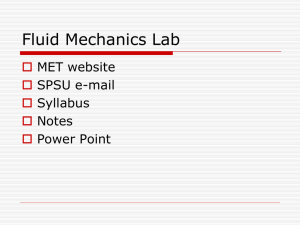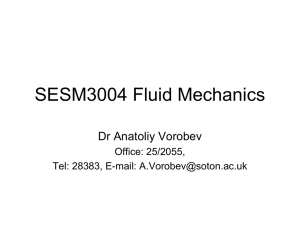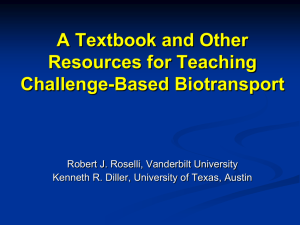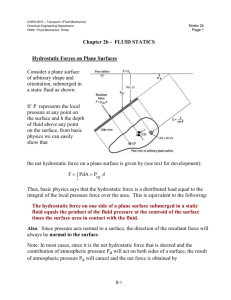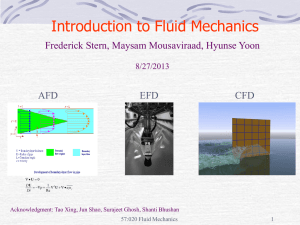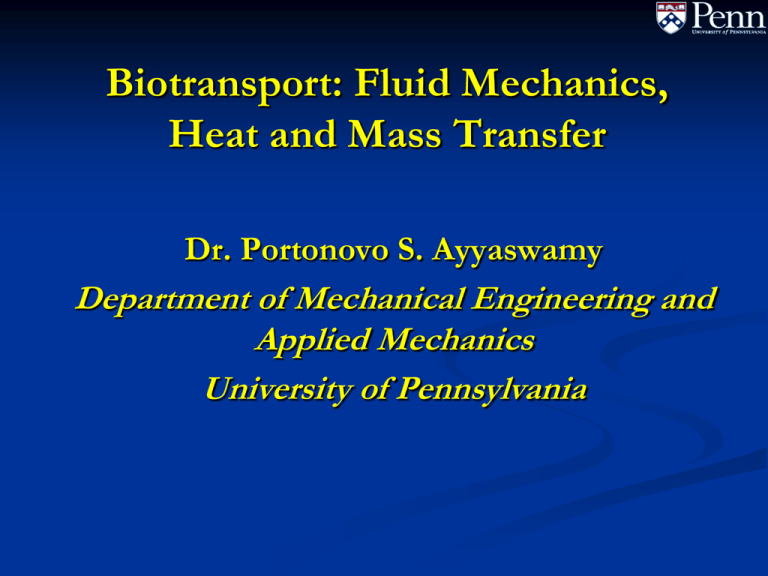
Biotransport: Fluid Mechanics,
Heat and Mass Transfer
Dr. Portonovo S. Ayyaswamy
Department of Mechanical Engineering and
Applied Mechanics
University of Pennsylvania
Abstract
There is an important need for comprehensive courses
related to Biotransport to be offered at the undergraduate and
graduate levels in US Universities.
These courses must emphasize both theory and applications,
motivating students to carry out careful experimentation
which will validate what they have learned in theory.
At present, although there are many different descriptions of
courses related to biotransport that are available in catalogues
of various departments, it is clear that a systematic approach
is needed to develop a formally comprehensive set of
guidelines and course material descriptions that will be useful
for the student body at large.
Abstract (cont’d)
As a part of this discussion, a comprehensive model course
description is displayed in the following.
This model will apply to undergraduate and graduate level
courses; the degree of detail, rigor, and emphasis will vary
depending on the level at which the course is offered.
Introduction to Biotransport
The role of transport processes in biological systems;
biological system description must include precise concepts
both from biology and from engineering. What constitutes a
biological system model must be addressed.
Multiphase (both on the basis of material composition and
thermodynamically distinct phases) are common in
biotransport.
Diffusion, convection, binding interactions, and cellular
transport are the most common types and must be clearly
discussed.
Introduction to Biotransport (cont’d)
Transport within cells and across membranes
Physiological transport systems: Consideration may be limited
to the cardiovascular system and the respiratory system since
they are well understood.
Review of Fundamentals of
Fluid Mechanics
Review of fluid properties and their ranges as functions of
pressure and temperature
Newtonian and non-Newtonian fluids: limits where fluids
may be considered Newtonian to an excellent approximation
Fluid statics, fluid kinematics; relevance to transport
phenomena
Laminar and turbulent flows as illustrated by examples taken
from systems
Review of Fundamentals of
Fluid Mechanics (cont’d)
Lagrangian and Eulerian view points of fluid flow; why are
these important and where such descriptions are suitable
Compressible and incompressible flows; examples of systems
where this distinction is critical
Inviscid and Irrotational Flows; Bernoulli and Euler
equations; examples in systems where these offer suitable
descriptions
Review of Conservation Relations in
Integral and Differential Forms
Control volume; fixed and moving; frames of reference
Basic equations in integral form, Reynolds transport equation
Applicable boundary (interface) and initial conditions
Review of differential forms of the equation of conservation
of mass, linear momentum and Navier-Stokes equation
Fluid motion with more than one dependent variable
Low, intermediate and high Reynolds-number flows
Blood Rheology:
Properties of Flowing Blood
Blood composition, viscosity, yield stress, Fahraeus-Lindqvist
effect
Power-law model, Casson model, Carreau-Yasuda model
Usefulness and shortcomings of existing models
Blood vessel structure
Circulatory Biofluid Mechanics
Systemic and Pulmonary circulations
Inviscid approximations; viscous flows and boundary layer
theory
Flow separation; examples from systems
Lubrication theory; limits of applicability
Peristaltic pumping
Fluid Flow in the Circulation and
Tissues
Introduction
Oscillating flow in a cylindrical tube
Entrance lengths
Flow in curved vessels
Flow in branching vessels
Fluid Flow in the Circulation and
Tissues (cont’d)
Flow in arteries
Flow in collapsible tubes
Heart-valve Hemodynamics
Introduction to non-Newtonian flows in tubes
Use of models in flow descriptions, arterial fluid dynamics
Mass Transport in Biological Systems
Introduction
Solute fluxes in mixtures
Conservation relations, Fick’s laws
Steady and unsteady diffusion
Diffusion-limited reactions, equimolar counter diffusion
Lumped parameter techniques; Compartmental models with
pharmokinetics
Mass Transport in Biological systems
(cont’d)
Transport across membranes
Conservation of mass for dilute solutions
Dimensional analysis
Electrolyte transport, diffusion and convection
Mass transfer coefficients
Mass transfer across membranes
Transport in Porous Media
Introduction
Porosity
Toruosity, and available volume fraction
Fluid flow in porous media
Solute transport in porous media
Fluid transport in poroelastic materials
Introduction to Molecular Transport
Within Cells
Receptors and Ligands
Binding kinetics, rate constants,
transduction, gene expression
Cell attachment and detachment
Rolling and adhesion
endocytosis,
signal
Introduction to Bio Heat Transfer
Basic concepts
Conservation of energy equation; thermal effects; role of
Prandtl number
Heat transfer to blood vessels
Equilibration lengths
Models of perfused tissues, continuum models, Pennes heat
sink model, directed perfusion model, effective conductivity
model, combination models
Introduction to Bio Heat Transfer
(cont’d)
Parameter values
Solutions of continuum models
Treatment of boundary conditions
Vascular geometry generating algorithms
Solution of coupled tissue-vascular models
Statistical interpretation
Applications of Theory Elasticity in
Biomechanics
Extension
Compression
Simple shear of soft tissue
Extension and torsion of a papillary muscle
Analysis of stress, strain and deformation
Recommended Books
(1) Transport Phenomena in Biological Systems by G.A. Truskey, F.
Yuan and D. F. Katz, Pearson Prentice Hall, 2004.
(2) Biofluid Mechanics—The Human Circulation by K.B. Chandran,
A.P. Yoganathan, and S.E. Rittgers, Taylor & Francis, 2007.
(3) Biomechanics: Mechanical Properties of Living Tissues by Y.C.
Fung, Second Edition, Springer, 1993.
(4) Biomechanics: Circulation by Y.C. Fung, Second Edition, Springer,
1997.
(5) Biofluid Dynamics: Principles and Selected Applications by C.
Kleinstreuer, Taylor and Francis, 2006.
(6) Biofluid Mechanics by J.N. Mazumdar, World Scientific, 2004.
Recommended Books (cont’d)
(7) The Fluid Mechanics of Large Blood Vessels by T.J. Pedley,
Cambridge Univ. Press, 1980.
(8) Introduction to Bioengineering by S.A. Berger, W. Goldsmith and
E.R. Lewis, Oxford, 1996.
(9) Nonlinear theory of elasticity: Applications in biomechanics by
L.A. Taber, World Scientific, 2004.
(10) Basic Transport Phenomena in Biomedical Engineering by R.L.
Fournier, Taylor and Francis, 2007.
(11) Introduction to Biofluid Mechanics by P.S. Ayyaswamy, Chapter
17 in Fluid Mechanics by P.K. Kundu and I.M. Cohen, Elsevier,
2008.
(12) Analysis of Transport Phenomena by William M. Deen, Oxford,
1998.



